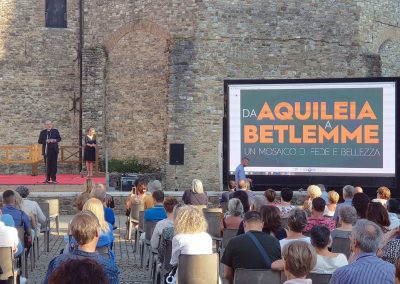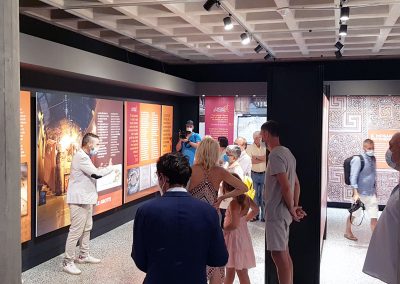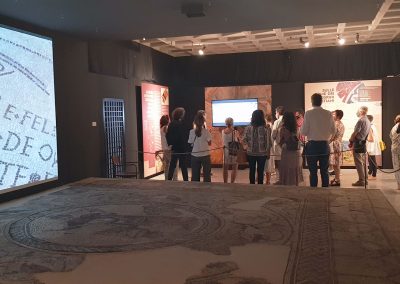From Aquileia to Bethlehem: a Mosaic of Faith and Beauty
The exhibition “From Aquileia to Bethlehem, a mosaic of faith and beauty” is an immersive and unmissable journey, full of history, art and archaeological insights. Walking among the columns and mosaics that regained their ancient splendor after restorations in the Basilica of the Nativity in Bethlehem, Palestine, it is easy to follow the emotions and memories of pilgrims who for centuries made their pilgrimage to the most important church in the world. One can then continue the itinerary in the Basilica of Aquileia, discovering its evolution over time.
The exhibition was inaugurated on Sunday, July 11th, 2021, at Palazzo Meizlik, in the heart of the ancient Friulian city.
This exhibition is well worth the visit to Aquileia, with the intention of traveling to Bethlehem as soon as possible to witness first-hand the wonders preserved in the Basilica of the Nativity. It celebrates the thread – hitherto unexplored – that binds Bethlehem to Aquileia, a bond of faith and beauty uniting two world heritage sites. In fact, as of July 2019, the Basilica of the Nativity is no longer a UNESCO endangered site, thanks to the quality of the work carried out on the church, particularly the restoration of the roof, the external facades, the wall mosaics, and the doors of the basilica.
Restoration was supported by the Palestinian National Authority and carried out from 2013 to 2020 by the Italian company, Piacenti, based in Prato. The exhibition has been endorsed by the Bethlehem Development Foundation and the High Presidential Committee for the Affairs of the Churches in Palest ine, and organized by the Aquileia Foundation in collaboration with the Municipality of Aquileia, the So. Co. Ba., with the support of Piacenti Spa and the patronage of the Ministry of Culture.
The exhibition spans over two floors and visitors are accompanied by detailed captions and videos that were prepared to provide accurate insights. On the first floor, the treasures of the Basilica of the Nativity are discovered, while on the ground floor the doors open to those of the Basilica of Aquileia. The West and the Middle East rediscover a strong bond: the ancient port on Italian soil, a crossroads for pilgrims heading to the Holy Land. “A thread little explored” linking the two cities, as noted by the Mayor of Aquileia Emanuele Zorino, and President of the Aquileia Foundation, during the inauguration in the square in front of the Basilica in the presence of the Patriarch of Jerusalem for the Latins, Monsignor Pierbattista Pizzaballa and Ambassador Mounir Anastas, Alternant Permanent Delegate of the State of Palestine to UNESCO, as well as the exhibit curators.
The well-attended event took place on the eve of the Feast of the Patron Saints of Aquileia, San Fortunato and San Ermacora. “An exhibition that goes further and makes us understand the importance of the territory of Aquileia in Europe, starting from a great work on cultural heritage,” the mayor said, adding that it is “a port that has created ties between people. The exhibition marks the beginning of a journey that will lead to a deeper understanding of these unexplored ties, starting with historical records and archaeological findings.” The link with Palestine was woven into the opening of the exhibition, thanks to a deferred intervention by Father Ibrahim Faltas, of the Custody of the Holy Land, President Hani Abu Dayyeh, as well as the director of the Bethlehem Development Foundation, Mazen Karam.
Ambassador Mounir Anastas expressed his gratitude for the high-quality exhibition, and his hope “that this collaboration between Aquileia and Bethlehem will be the beginning of a long relationship of cooperation. The restoration of stones, frescoes and mosaics are very important, but what matters most for the inhabitants of Bethlehem is that the local communities and the millions of pilgrims ensure that the heritage is a living heritage and not a museum”. The ambassador expressed a wish: “I hope to see you at the next edition of the exhibition in Bethlehem”.
Giammarco Piacenti, CEO of Piacenti, was awarded an international tender to illustrate the seven years of restoration conducted in Bethlehem and the privilege of working on never-before restored artifacts to discover the history kept inside them. “We thought this work could not remain closed in the pages of books. Together with the Bethlehem Development Foundation and the Palestinian Committee we thought it was appropriate to make it fully known – with exhibitions that could tell both the restoration and the history of the pilgrims, their voices that over time tell their stories. Hence the idea of this exhibition: to combine the European crossroads with the Middle Eastern center from which the history of Christianity began”.
Monsignor Pierbattista Pizzaballa, cut the ribbon of the exhibition together with Mayor Emanuele Zorino and Ambassador Mounir Anastas. “The Holy Land is often remembered for wars, tensions and difficulties both on a political, social and economic level” he said, “framing the epochal work of the restoration of the Nativity, the church commissioned by Emperor Constantine so as not to forget the place where according to tradition Jesus was born”. He continued: “The intervention in Bethlehem was not taken for granted in such a divided context, starting with the three religious communities present in the church. The restoration began several years ago, when churches throughout the Middle East were burned or destroyed: a hard, difficult period, but the results have been outstanding. An important outcome which highlights its social importance is that Christians and Muslims worked together to restore this national monument, not only for their religious communities but primarily for the Palestinian people. The Palestinian people, so deeply wounded in their history, waiting interminably to obtain the right to live in peace in their homeland, also wanted to take part in restoring that monument. Symbolically it was a very important work.”
Monsignor Pierbattista Pizzaballa afterwards framed the recovery intervention in a broader dimension: “The Nativity had become a dark place but now it has become a place that gives light, so that our community has recovered a relationship with that monument ”, he commented, adding “So this exhibition is not just an overview of the past, but unites the East and the West, showing us how these two worlds have always spoken to each other and have always been in connection with each other: Aquileia was one of the doors through which Christianity entered and developed in Europe”.
Salvo Barrano, archaeologist and representative of the Ministry of Culture on the board of the Aquileia Foundation, finally underlined how the international exhibition was “a rather courageous challenge that allows Aquileia to take the role it deserves in the international cultural arena, linking this site to the Mediterranean and to the Middle East. Aquileia must strongly claim this role”. The day ended with guided tours by the curators of the exhibition. While complying with COVID safety regulations, they explained the path of the exhibition to the many people present and answered the questions from the public.
The exhibition at Palazzo Meizlik unfolds in two sections: the Bethlehem section, is curated by Taisir Hasbun, Alessandro Fichera and Tommaso Santi, and ends with a video where the Basilica is revealed in its newfound beauty. Issa Kassissieh of the Palestinian Presidential Committee brought attention to the spirit that animates the exhibition: “It is with humility and at the same time with pride that the Palestinian people present Bethlehem and its church to the world. We believe that through the beauty and power of art, history, culture and faith, we can truly promote knowledge between cultures, strengthen interreligious dialogue and serve as an inspiration for the progress of future generations”.
The Aquileia section, curated by archaeologists Salvo Barrano and Luca Villa, leads to the origins of Christian art by investigating in depth the relationship between these two cities, separated by over two thousand miles. The exhibition can be visited Tuesday to Sunday from 10:00 to 19:00. Entrance tickets to the exhibition (€ 6) also include the entrance to the Basilica of Aquileia, the crypt frescoes and the crypt excavations, allowing visitors to continue the path to the discovery of the wonders of the Basilica of Aquileia. The catalogue, with texts by the curators and a rich photographic repertoire, as well as the DVD, “The Wonders of Bethlehem”, are available at the exhibition bookshop.
Sara Bessi
Redazione Prato – La Nazione
Tel. +39 0574612411
Via G.B. Mazzoni 13
59100 Prato



